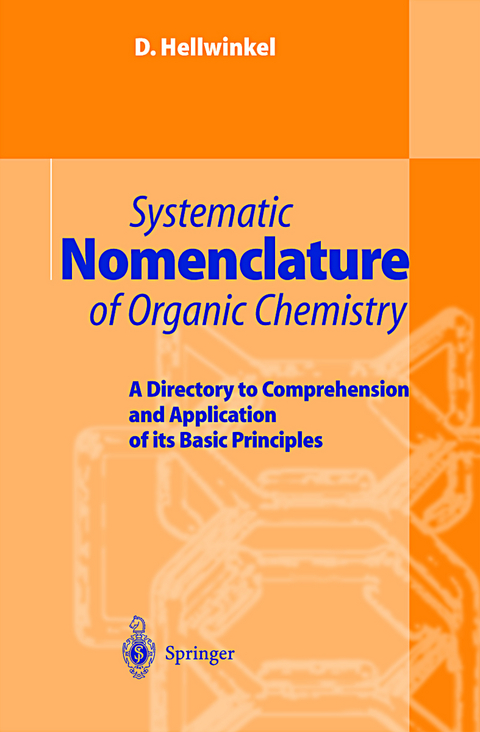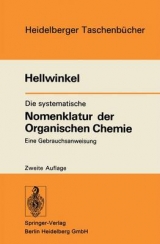
Systematic Nomenclature of Organic Chemistry
Springer Berlin (Verlag)
978-3-540-41138-3 (ISBN)
Literature.- 1 Parent Structures.- 1.1 Acyclic Hydrocarbon Systems.- 1.2 Cyclic Systems.- 1.3 Phane Nomenclature.- 2 Substituted Systems.- 2.1 Preliminary General Remarks.- 2.2 Nomenclature Types for Substituted Systems.- 3 Brief Demonstration of the General Nomenclature Rules for the Most Important Traditional Compound Classes (Functional Parents).- 3.1 Carboxylic Acids, Sulfonic Acids etc. and their Derivatives.- 3.2 Nitriles, Isocyanates, and Similar Compounds.- 3.3 Aldehydes and Ketones.- 3.4 Alcohols, Phenols, and their Derivatives.- 3.5 Ethers and Thioethers.- 3.6 Amines, Imines, and their Derivatives.- 3.7 Halogen Derivatives.- 3.8 Compounds with Nitrogen Chains.- 3.9 Hydrazines and their Derivatives.- 3.10 Diazo- and Diazonium Compounds.- 3.11 Compounds with Chains of Three or More Nitrogen Atoms.- 3.12 Other Polynitrogen Parent Systems.- 4 Metalorganic and Metalloidorganic Compounds.- 4.1 Element Hydride (Elementane) Names.- 4.2 Functionally Substituted Elementanes.- 4.3 Elementanes with Repeating Diads.- 4.4 Organic Derivatives of Alkali and Alkaline Earth Metals and Comparable Compounds.- 4.5 "ate" Complexes.- 5 Carbohydrates.- 5.1 Aldoses.- 5.2 Ketoses.- 5.3 Ketoaldoses (Aldoketoses, Aldosuloses).- 5.4 Deoxy Sugars.- 5.5 Amino Sugars and Analogously Substituted Derivatives.- 5.6 Transformations of the Carbonyl Functions.- 5.7 Branched Sugars.- 5.8 Sugar Alcohols (Alditols).- 5.9 Acids Derived from Sugars.- 5.10 O-Substitution.- 5.11 Monosaccharides as Substituent Groups.- 5.12 Glycosides and Glycosyl Compounds.- 5.13 Oligosaccharides.- 5.14 Customary Trivial Names.- 6 Construction of the Names of Complex Compounds.- 6.1 Determination of the Highest Ranked Chain (Main or Senior Chain).- 6.2 Determination of the Most Senior Ring System.- 6.3 Treatment ofthe Most Senior Characteristic Group in the Light of the Two Preceding Paragraphs.- 6.4 Numbering.- 6.5 Order of Prefixes.- 6.6 Isotopically Modified Compounds.- 6.7 Specifications of Stereochemistry.- 7 Appendix.- 7.1 Complete List of "a" Terms Utilized in Replacement and Heterane Nomenclature.- 7.2 Tables of Customary Trivial (and Semitrivial) Names.
From the reviews:
"A good text on this subject should be clear (ambiguity is not desirable) concise and authoritative. Hellwinkel's book, Systematic nomenclature of organic chemistry, is all of these. (...) Had I bought this text as an undergraduate it would now be sitting on my desk looking dog-eared and thoroughly worn-out. This will be the sort of book which will constantly be useful."
Ian Farrell
Journal: Chemistry World, The Royal Society of Chemistry, Vol. 1, Issue 4, Page 61
"Chemical nomenclature is rather like visiting the dentist: nobody enjoys it ... . A good text on this subject should be clear (ambiguity is not desirable) concise and authoritative. Hellwinkel's book, Systematic nomenclature of organic chemistry, is all of these. ... Had I bought this text as an undergraduate it would now be sitting on my desk looking dog-eared and thoroughly worn-out. This will be the sort of book which will constantly be useful." (Ian Farrell, Chemistry World, Vol. 1 (4), April, 2004)
"Hellwinkel has produced a brief but comprehensive introduction to the systematic nomenclature of organic compounds. ... Using the current recommendations of The International Union of Pure and Applied Chemistry (IUPAC), Hellwinkel offers simple and concise guidelines for producing systematic names ... . The book contains a comprehensive list of current references and will be suitable for undergraduate or graduate students of organic chemistry. Anyone who needs to create or interpret the names found in the ... literature would find this book to be useful." (Patton M. Giles, Jr., Journal of the American Chemical Society, Vol. 123 (46), 2004)
"This book ... is reasonably tightly focused on those aspects of organic nomenclature most likely to be encountered for 'typical' molecules and, because it is soft-cover, has a very attractive price ... . Recommended systematic nomenclature is covered in good detail ... . The book includes 35 tablescontaining many example molecules. ... The index ... includes functional group suffixes, making it possible to use the book in the reverse mode of assigning molecular structure with a name already in hand." (C.J. Cramer and D.G. Truhlar, Theoretical Chemistry, Vol. 107 (2), 2002)
"Hellwinkel's approach to organic nomenclature mirrors IUPAC nomenclature ... . The demonstration of the nomenclature rules ... is most instructive as it surveys and applies the general nomenclature principles behind the naming conventions. ... The beginner, non-specialist and expert chemist will find the survey of the guidelines and examples provided in this book very instructive and invaluable in providing solutions to nomenclature problems." (Helmut M. Hügel, Chemistry in Australia, 2001)
"This book gives a short and general introduction to the systematic nomenclature of organic compounds. On the basis of carefully selected examples it offers simple and concise guidelines for the generation of systematic compound names codified by the IUPAC rules. ... the author's motivation for writing this book is his conviction that a basic insight into the language of chemistry is a vital part of every chemist's basic training." (LabPlus International, Vol. 15 (3), 2001)
| Erscheint lt. Verlag | 27.3.2001 |
|---|---|
| Zusatzinfo | X, 230 p. |
| Verlagsort | Berlin |
| Sprache | englisch |
| Maße | 133 x 205 mm |
| Gewicht | 267 g |
| Themenwelt | Medizin / Pharmazie ► Pharmazie ► PTA / PKA |
| Naturwissenschaften ► Biologie ► Biochemie | |
| Naturwissenschaften ► Chemie ► Organische Chemie | |
| Schlagworte | Chemical documentation • Chemische Dokumentation • Isotop • Monosaccharid • Oligosaccharid • Organic Chemistry • Organic Compounds • Organische Chemie; Lexikon/Nachschlagewerk • Organische Verbindungen • stereochemistry • Systematic nomenclature • Systematische Nomenklatur |
| ISBN-10 | 3-540-41138-0 / 3540411380 |
| ISBN-13 | 978-3-540-41138-3 / 9783540411383 |
| Zustand | Neuware |
| Haben Sie eine Frage zum Produkt? |
aus dem Bereich



